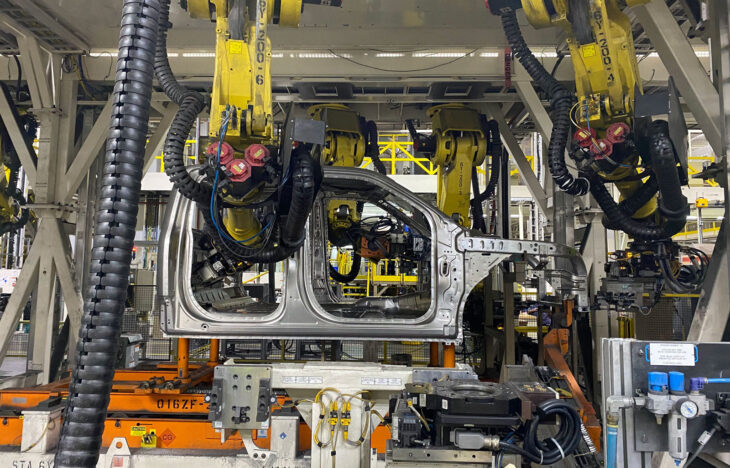By Rose Eaton, Light Metal Age.
Ford’s use of aluminum began slowly over time, beginning with closure applications in hoods, fenders, and decklids, until it became an integral part of the Ford F-150 truck in 2014. Now, throughout each new iteration of the large truck, including the new 2022 F-150 Lightning electric vehicle (EV), high-strength aerospace grade aluminum alloys are used for the entire body-in-white (BIW), taking advantage of the metal’s strength, corrosion resistance, and weight savings qualities.
When Ford began to use aluminum in the structural BIW, the OEM knew that this choice would drastically reduce the weight of the F-150, making it more agile and saving customers thousands of dollars in fuel costs. Moreover, the lighter weight trucks would help Ford reach the ever more strict CAFE standards on fuel emissions. Accordingly, the company was preparing for a great response from the public. However, when the aluminum bodied F-150 first debuted eight years ago, it sparked controversy amongst truck enthusiasts about whether the aluminum truck bed could hold up to steel. There were public misconceptions about the strength of aluminum, mostly driven by the steel industry’s efforts to keep a strong foothold on the automotive industry. Ford’s competitor Chevrolet even released TV commercials criticizing the aluminum truck beds, making it to appear that they would sustain damage under extreme conditions.
Soon, however, the contention over the aluminum truck bed (Figure 1) was quelled, when Ford disproved claims against the strength of aluminum through a rigorous testing process. To make sure the truck bed could withstand the most severe conditions, six F-150 trucks with high-strength, military-grade, aluminum alloy cargo boxes were placed with a mining company, an energy utility company, and a construction firm to monitor performance.
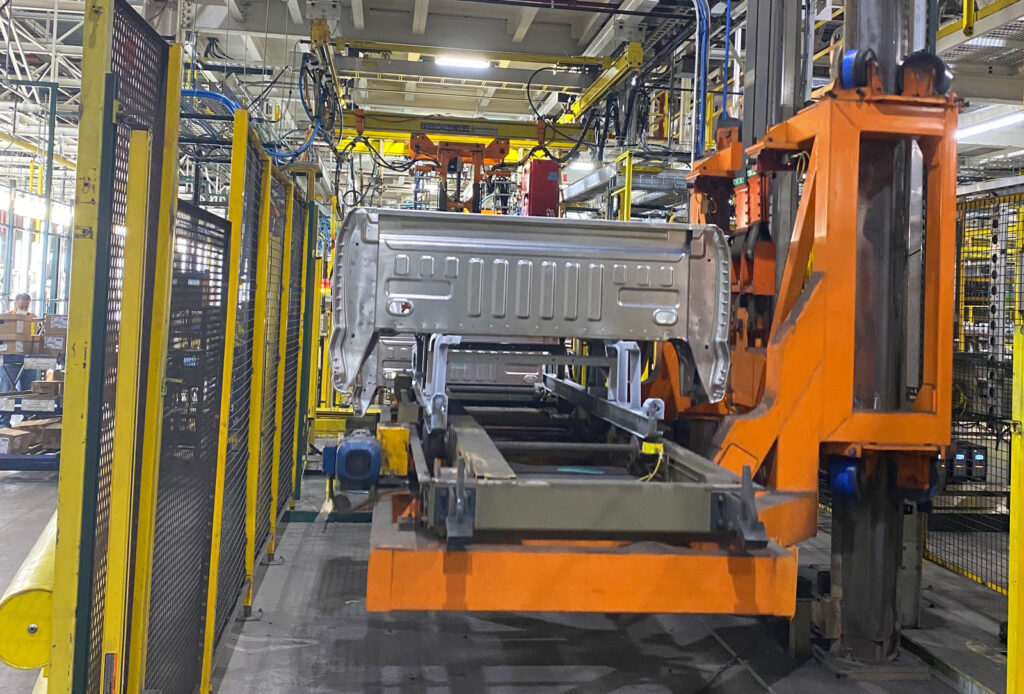
The customers were told to drive and treat the trucks as they normally would in their daily working routines. Two years and more than 300,000 miles of abuse, teardowns, and inspections resulted in new engineering tests and design changes to ensure the production box would be ready to handle customers’ demands.
“The F-150 is tested to extremes because truck buyers want the best equipment to do the toughest work and perform under the toughest conditions,” said Ford development manager, Peter Frantzeskakis. “Severe testing that goes beyond customer expectations and thorough analysis of those results is how Ford makes F-150 the No. 1 truck.”
Aluminum Put to the Test
Constellium, headquartered in Paris, France, has supplied Ford with rolled and extruded components for Ford’s aluminum-intensive trucks, providing high-strength aluminum alloys, which are already used in aerospace, commercial transportation, energy, and other rugged industries. Overall, up to 700 lbs of weight were saved after the switch to the aluminum BIW, helping the F-150 tow more, haul more, accelerate quicker, stop shorter, and be more efficient.
Ford engineers selected these military-grade, aluminum alloys because of the metal’s unique ability to withstand tough conditions. “Our objective was to find materials that allowed us to design the truck to be as tough—or tougher—yet could help it be hundreds of pounds lighter for better capability and fuel economy,” said Pete Friedman, manager, Ford manufacturing research. “Out of all the materials we tested, we carefully selected only certain grades of aluminum that met our high-performance standards in all of our tests, while allowing us to trim hundreds of pounds from the truck.”
Weight savings from aluminum alloys help the F-150 reduce its lifetime emissions compared to the previous steel-body versions. The reduced weight enabled the F-150 to tow and haul more than ever, while also improving acceleration, braking, and handling performance. Adding to these benefits, aluminum alloys will not rust and are resistant to corrosion, helping to extend vehicle life.
The original 2015 aluminum Ford F-150 underwent more than 10 million miles of testing by the time it went on sale. “We put the truck through some of our testing longer and further than we have ever done before,” said Frantzeskakis. “The testing was fantastic from a durability perspective. The aluminum box exceeded our expectations in a lot of areas.”
Particular attention was paid to the new aluminum body panels and how they are fastened to the frame. One test simulated six years of use in six weeks. After a complete teardown and inspection, the team developed new ways to prevent scratching the e-coat corrosion protection on the frame and eliminated spots where water could settle.
Since the change to the aluminum BIW, the Ford F-series has continued to hold the U.S. title for the Best Selling Pickup, a position it has held for more than 40 years.
BIW Assembly Plant
Light Metal Age toured Ford’s Dearborn, MI, F-150 plant in October 2021 and witnessed numerous aluminum truck bodies being assembled. Innovation is still the name of the game in Dearborn to this day, at the same location where Henry Ford installed the first moving assembly line for the mass production of an entire automobile in 1913. Today, the company makes over 1,000 trucks per day.
In the F-150 truck body assembly plant, robots do a majority of the work, from moving parts around the facility to attaching the BIW to the vehicle’s frame. Aluminum body parts of the F-150 are joined to a high strength steel frame by robots using self-piercing rivets, along with clinches and flow-drill screws (Figure 2). Workers are stationed along the assembly line for quality checks and to perform some of the more critical tasks. Laser welding and resistant spot welding are also used in the production of the F-150 in areas where these joining methods can provide benefits over the mechanical joining technologies mentioned. Furthermore, Ford uses structural adhesives in conjunction with both types of joining technologies to provide additional strength and stiffness where necessary.
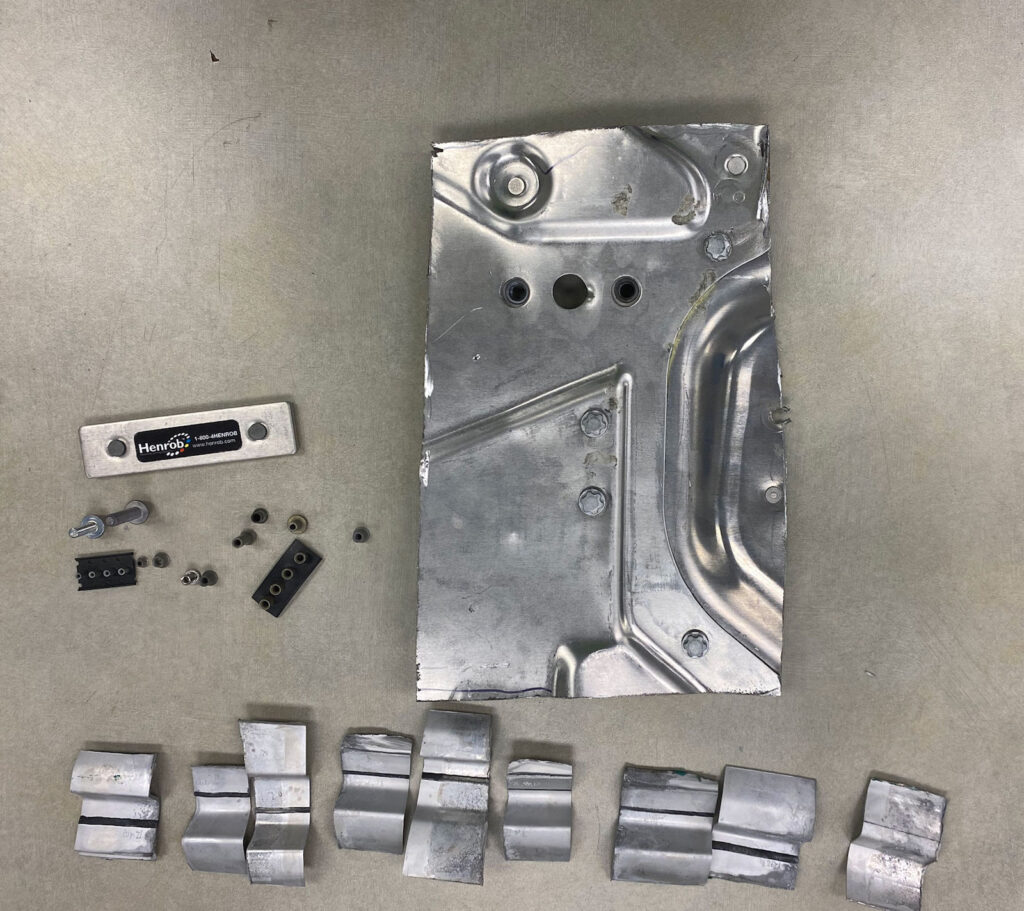
In the 2021 all-aluminum F-150 model, the 5.5 ft crew cab box (Figure 3) of the BIW weighs approximately 550 lbs, of which a near 500 lbs is aluminum. Altogether, Ford uses more than ten different aluminum grade and temper combinations on the F-150 between the stamped, roll-formed, and extruded parts. Each grade/alloy combination was designed for the many different requirements needed for the F-150, such as hem performance, surface quality, or high-strength.
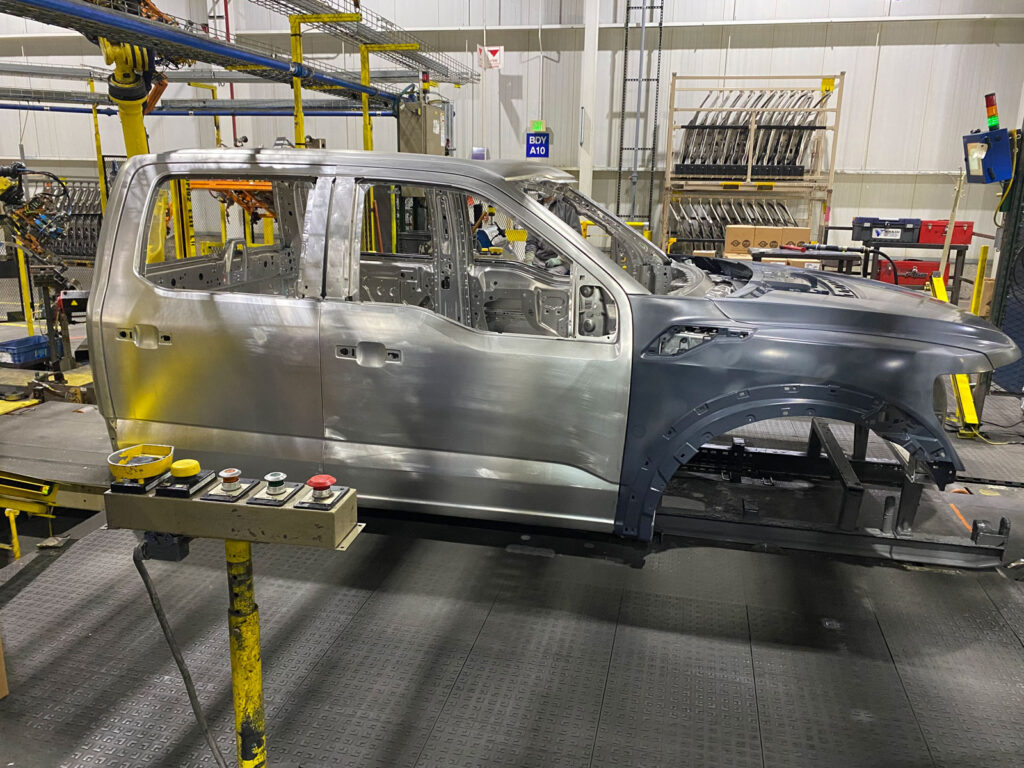
Closed-Loop Recycling
Ford’s closed-loop recycling system recovers aluminum scrap during parts stamping at the Dearborn stamping plant, which provides parts to build F-150s at Ford’s Dearborn Truck Plant and its Rouge Electric Vehicle Center.
The OEM worked closely with the aluminum sheet suppliers to create unique alloys just for closed-loop recycling. Aluminum scrap is recovered during the parts stamping process, and the different aluminum alloys are separated so they can be recycled back into fresh aluminum for new vehicles.
This system recovers up to 20 million lbs of high-strength, military-grade aluminum alloy per month, which saves 95% of the energy that would be required to create new aluminum from raw ore.
The Truck of the Future
Earlier this year, Ford stopped taking reservations for their new F-150 Lightning EV (Figure 4), the company’s first electric truck, after having collected 200,000 refundable $100 deposits since the truck was debuted in May 2020. The production target from Ford’s Rouge Electric Vehicle Center is 150,000 units by mid 2023. In late May 2022, the Lightning was delivered to its first customer in Michigan.
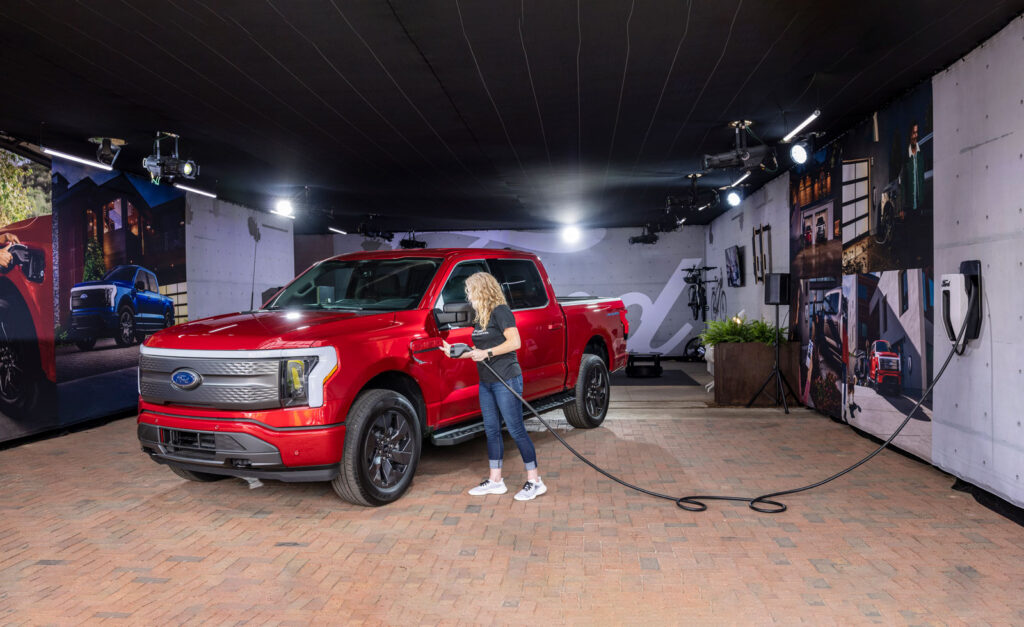
The EV has an EPA-estimated range of 320 miles and comes equipped with Intelligent Range. The program helps calculate range based on past driver behavior, weather conditions, speed, terrain, and even towing and payload to predict how much energy will be used in future driving. If the range is impacted notably by any number of factors, the driver will receive a notification highlighting the new range estimate and details about why the estimate changed. In addition, Ford teamed up with energy company Sunrun to offer an in-home charging package for the Lightning, and they provide two years of Blue Oval Charge Network access at Electrify America (EA) stations.
The F-150 Lightning, like other F-Series pickup trucks, extensively uses high-strength aluminum alloys. Constellium will also be supplying aluminum structural components for the all-electric Ford F-150 Lightning, including the windshield header, rocker, radiator support, and other unspecified parts. The auto body sheet will be supplied from the company’s Bowling Green, KY, facility.
“Constellium is proud to supply the electric Ford F-150 Lightning with recyclable aluminum and to contribute to Ford’s commitments to sustainability,” said Philippe Hoffmann, president of Constellium’s Automotive Structures & Industry business unit. “Aluminum is the metal of choice for electric vehicles and our light, strong, crash- and intrusion-resistant solutions help make electric vehicles safe and more sustainable.”
Sustainable Manufacturing
Ford is building the all-electric Lightnings at its new state-of-the-art Rouge Electric Vehicle Center at the Rouge complex in Dearborn, MI. The zero waste-to-landfill site will employ advanced sustainable manufacturing technology to build the truck as part of Ford’s commitment to become carbon neutral by 2050. The company has invested a total of $950 million and created 750 new jobs at the site, which will support battery assembly and production of the new electric vehicles.
Editor’s Note: This article first appeared in the June 2021 issue of Light Metal Age. To receive the current issue, please subscribe.

